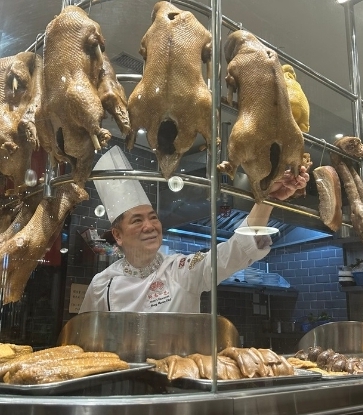Sometimes, being a regular of a Cantonese restaurant means you get to try something special that’s not on the menu.
These dishes are known to insiders as best-kept secrets at their favourite restaurants—but that doesn’t mean others don’t get to order them.
Truth is, some of these items don’t make it to the menu because they are traditional dishes that are time-consuming and laborious to prepare, and certain ingredients are simply seasonal or in short supply.
Want to switch up your usual order? We’ve unearthed nine off-menu dishes from Hong Kong’s top Cantonese restaurants that you have to be in the know to ask for.
SEE ALSO: The Most Laborious Dishes By MICHELIN-Starred Restaurants

Forum
Three MICHELIN Stars, MICHELIN Guide Hong Kong Macau 2021
Three Stuffed Treasures(煎釀三寶)
For many Hongkongers, "Three Stuffed Treasures” evokes flavours of childhood. An ode to Hong Kong street food, Forum’s version looks more or less like the original snack, but it is the ingredients that make a world of difference.
"We present this secret dish with a brown paper bag and wooden sticks, just like the actual ‘Three Stuffed Treasures’,” says chef Adam Wong, the executive chef of Forum. “We also serve it with bottles of sweet sauce, spicy sauce and soy sauce—the classic sauces that usually come with the snack.”
"The difference is, this snack is traditionally stuffed with only minced fish meat, but our version is made with a stuffing of minced miniatus grouper, lobster and fresh prawn meat—the best produce from the ocean.”
The mince is then stuffed into green and red bell peppers, eggplant, and even chilli pepper if the guest likes spicy food. Every serving contains three stuffed "treasures".
“It’s not on the regular menu because each stuffed 'treasure' is made using the most premium catch from the ocean, which means ‘Three Stuffed Treasures’ for the whole table would cost over a thousand Hong Kong dollars. Only my regulars know this dish because they know the value behind it, otherwise most people would be surprised that this traditional street food, which usually costs no more than twenty Hong Kong dollars, has such a high price tag.”
“This dish ‘wows’ our guests every time—it’s like unwrapping a gift. It’s usually sold roadside but we give it a three-MICHELIN-starred twist so they can enjoy it in the comfort of our restaurant.”
Since only fish meat is used to make the stuffing, the rest of the fish and shrimp head are deep fried with salt and pepper so nothing goes to waste. Other cooking methods like stewing or steaming are also available upon request. The remaining lobster is usually boiled into a soup.

Fish "Char Siu”/ Barbecued Fish(魚叉)
"We have regulars who dine at Forum once or twice a week—they’ve virtually tried everything on the menu,” says Wong. “"hen they ask for something special, this is the dish we present.”
When we think about "char siu”, the first thing that comes to mind is barbecued pork. While beef “char siu” is getting popular in recent years, fish "char siu” is almost unheard of—except as an off-menu dish at Forum.
Once marinated with "char siu" sauce for around 20 minutes, the Japanese amadai fish is pan-fried on the scale down with a bit of oil, just enough to cover the skin so it becomes beautifully crisp while the meat remains soft and succulent. The fish is then left to steam with the lid on to lock the moisture inside.
Even guests who know about this dish need to pre-order, as the amadai fish gets flown in fresh from Japan.

Baby Chicken(寶貝雞)
With a name that literally means "Baby Chicken” in Cantonese, one of Forum’s most talked-about off-menu dishes is a riff off a classic Cantonese dish called “Eight Treasure Duck,” which is usually stuffed with lotus seed, dried lily, salted egg yolk, Jinhua ham, barley, red beans, peanuts and glutinous rice.
"Baby Chicken” is essentially an elevated version of "Eight Treasure Duck”, comprising braised Ah Yat abalone—named after the restaurant’s legendary chef-owner Yeung Koon-yat—together with Japanese conpoy, Jinhua ham, and shiitake mushroom as the four main premium ingredients stuffed inside the chicken.
The whole boneless chicken, which comes from the Loonggang district in Shenzhen, is braised for an hour until it’s fork-tender. The secret ingredient is Ah Yat’s abalone sauce, which comes from either the 38-head or more high-priced 20-head canned abalone. It is then presented tableside for four servings.
The dish is so popular that it’s now available for pre-order 24 hours ahead.

The Chairman
One MICHELIN Star, MICHELIN Guide Hong Kong Macau 2021
Steamed Grouper Fish Head with Fermented Chilli and Lard(剁椒龍躉頭)
"This dish was inspired by our four-hand dinner with Foshan’s 102 House when we invited them over to Hong Kong in 2018,” says Danny Yip, the owner of The Chairman. "Their cuisine is unpretentious, and the chefs are young and creative. At that time, we wanted to create a substantial dish that would have a 'wow' effect, so we decided to use the grouper head, which is rich in collagen and is able to carry the intense flavours of the fermented chili.”
Also known as Hunan-style pickled chili, the chopped Er Jing Tiao chili from Sichuan and green chili from Guangdong are fermented with salt to develop an umami flavour and a distinctive tang.
"This dish is off-menu because the grouper fish head has a limited supply—but it can be pre-ordered.”

Camphor Wood Smoked Goose(樟木煙熏鵝)
Following the principle of “less is more,” Yip believes that each dish should focus on one punch of flavour.
"Two years ago, we wanted to create a minimal dish with as little ingredients as possible, so we spent months experimenting until we settled on the goose,” says Yip. "We thought of ways to make the goose more flavourful without adding anything—camphor wood is very fragrant especially when it's smoked so we thought it'd be a good match.”
The whole preparation takes three days in total. The goose is first marinated with poultry stock for two nights before it’s steamed for six hours to remove the excessive fat. It is then air-dried overnight and smoked with camphor wood the next day. Before it’s served, the goose is lightly deep-fried to make the skin even crispier. The result is paper-thin skin and juicy, tender meat that require no accompaniments.
Needless to say, pre-ordering is required—the whole goose is enough for six guests, while half a goose can feed four guests.
RELATED: The Chairman's Owner Danny Yip On His Favourite MICHELIN Restaurants

Geoduck Poached in Rice Broth with Shrimp Oil (魚米粥蝦籽象拔蚌)
The Chairman is all about going back to the basics, so it’s no surprise that their simplest dishes—even a bowl of plain congee—receive careful attention.
"Our plain congee has been popular for a while, mostly because of its silky smooth texture and rich rice flavour. But at the end of the day, a plain congee is a complement to the main dish rather than a standalone dish,” says Yip. “We asked ourselves: how do we make the plain congee more substantial in a way that it’s no longer just a supporting act?”
On a quest to level up the plain congee, Yip and his team tried cooking the congee with different seafoods, like lobster, clipper lobster, fish and clams, but the best result came from the geoduck, "Geoduck is very rich in umami and has a silky texture to match the congee.”
To complete the dish, a few drops of homemade shrimp oil is drizzled on top to add a savoury punch.

Seventh Son
Guangdong-style Sliced Noodle Soup with Dumplings(水餃片兒面)
A rather high-end dish that was popular in the 1930s, the Guangdong-style sliced noodle soup is usually served with crab meat, but the discerning guests at Seventh Son demanded something different.
The handmade dumplings at Seventh Son have always been a hit, so chef Chan Kwok-wai decided to serve it with the sliced noodle soup. The combo is as refreshing as it is comforting, breathing new life into a traditional Cantonese dish that is on the verge of disappearing.
“We (traditional Cantonese chefs) know the steps and recipe for this dish by heart, but young chefs these days may not even have heard of it, let alone knowing what it tastes like," says chef Chan.
The “noodle" is basically wonton wrappers, which are deep-fried before they are rinsed in cold water to remove any excessive oil. After this, the wonton wrappers are boiled in a clear soup made with chicken and ham for two to three minutes.
The handmade dumplings are prepared with a prawn, crab and fish meat filling, served separately with the silky smooth noodles. While the dish may look simple, the whole process takes roughly an hour so it’s best to pre-order to avoid the wait.

Money Chicken(金錢雞)
Once a dish for the working class, "Money Chicken” is made with pork fat, chicken liver and pork meat—ingredients that are considered leftovers from Chinese butcher shops. It was until the 1970s, when Hong Kong’s economy began to flourish, that this dish became a signature dish at high-end Cantonese restaurants.
The preparation of this dish is extremely technical and time-consuming, which explains why many Cantonese restaurants are no longer serving it. The pork fat, for example, is marinated with white sugar and refrigerated for at least a day before it’s ready to use. The chemical reaction will strip away the oil and greasiness from the pork fat, leaving only a transparent layer referred to as the "ice meat.”
The pork fat, chicken liver and pork meat are then marinated with "char siu” sauce before it’s barbecued on a stick for roughly 30 minutes until caramelised.
The name "Money Chicken” describes the appearance of the trio, which takes on a deep, reddish brown glaze and has a hole in the middle when the stick is removed, which resembles the look of an ancient Chinese coin.

Traditional Siu Mai(懷舊燒賣)
Siu mai, or steamed pork dumpling, is a quintessential dim sum in Cantonese cuisine. Seventh Son’s traditional siu mai shares a filling similar to regular siu mai, which consists of ground pork meat, shiitake mushroom and spring onion, but the one ingredient that makes all the difference is a small piece of deep-fried salted fish in the middle.
The salted fish, known for its intense salty flavour, adds a subtle fragrance to the pork meat, which is finely chopped by hand to ensure the filling remains juicy and meaty. WIth a slightly bigger size than regular siu mai, they are steamed in a bamboo basket for 10 minutes until cooked. The siu mai can be enjoyed without dipping in soy sauce as the salted fish already gives a savoury taste.
This off-menu dish is available upon request during lunch time as a dim sum, or as an appetiser before dinner.
CONTINUE READING: Where To Get The Best Beef Brisket Noodles In Hong Kong





















